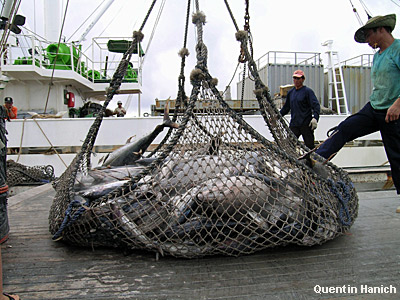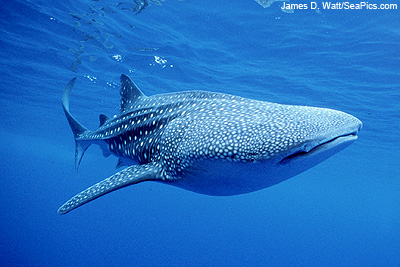International Policy Western and Central Pacific Fisheries Commission 2012
Scale up management
Some people think of tuna in the Pacific as the equivalent of oil: a resource that can lead to development, livelihoods, and wealth; the difference is that tuna, if managed wisely, can last forever. With a regional tuna catch worth $5.5 billion, the challenge is how to balance wealth, opportunities, and investment with sustainability and a healthy ocean. The Western and Central Pacific Fisheries Commission (WCPFC) has a unique and important responsibility both for the world’s largest tuna fishery and for the sharks that inhabit the waters of the WCPFC convention area. These responsibilities require strong conservation action through joint commitments.
Find out what happened at the seventh annual meeting in Guam earlier this year.
Watch our video on WCPFC:
Fast Facts on the WCPFC
.jpg)
The WCPFC is the newest and largest of the tuna regional fisheries management organizations (RFMOs).
It is responsible for the open-water fishing that takes place in an area that covers almost 20 percent of the Earth's surface.
A large proportion of the tuna in the Pacific comes from the territorial waters of Small Island Developing States or “Large Aquatic States” as many prefer to be called. These developing countries may have small land areas, but with waters extending 200 miles from shore, they are huge in terms of ocean resources.
WCPFC member governments have committed to valuing the unique social, economic and geographic characteristics of the region. However, there are challenges in balancing the aspirations of developing coastal States with the historical and current fishing by distant-water fleets from the United States, European Union, Japan, Republic of South Korea, and Taiwan (also known as Chinese Taipei).
The 25 members of the WCPFC will gather in Manila from 2-6 December for the Commission's ninth annual meeting to discuss ways to conserve tuna and to consider measures to protect threatened shark species.
Members will also look at ways to combat illegal, unreported and unregulated (IUU) fishing.
Tuna

More than half of the world's tuna catch comes from waters managed by the WCPFC.
According to the scientific body that advises WCPFC members, bigeye tuna are already experiencing overfishing, yellowfin tuna are fished to the limits of sustainability, and skipjack tuna are within sight of this limit. There are currently no science-based catch limits for Pacific bluefin tuna—the only bluefin tuna without catch limits.
The use of fish aggregating devices (FADs) will also be discussed.
FADs are huge floating fishing “rafts” used increasingly by the tuna fishery to attract schools of fish which gather beneath them.
Purse seine fleets set nets around these artificial devices to catch the schools of tuna that gather beneath the FAD, along with other marine species. The use of these devices contributes to marine litter and kills individuals of many other species as “bycatch”, particularly sharks, billfish and juvenile tunas.
Sharks

Although WCPFC has the clearest mandate to protect sharks of any RFMO, it has only taken meaningful action for one shark species.
As in many other fisheries around the world, fishermen using nets and longlines in the Western and Central Pacific region, often catch sharks deliberately or inadvertently.
High demand and prices for shark fins in Asia means that fishermen often have little incentive to release these animals alive.
This year, there will be discussions about how to reduce the impact of WCPFC fisheries on ‘at risk’ shark species such as silky, oceanic whitetip and hammerheads; to prevent purse seine tuna vessels from intentionally setting nets around whale sharks, and improve the existing shark finning ban.
IUU Fishing
About one-fifth of fish taken from the ocean are estimated to be illegal or unreported.
A study estimated the economic loss from IUU fishing in the western and central Pacific Ocean region to be 21 to 46 percent of the reported catch, which is valued at up to US$1.5 billion a year.
Some States allow their ports to be used by illegal operators, sometimes unwittingly. Others, either on their own or in cooperation with like-minded States, have started to tighten port controls as a means of closing the market to IUU-caught fish.
Until IUU fishing is stopped and Fishing Vessels appropriately identified and tracked, WCPFC's ability to manage and monitor fisheries in the region is likely to be undermined.
Pew's specific recommendations to the ninth session of WCPFC:
The Pew Environment Group calls on WCPFC members to take the following critical actions at the 9th Regular Session of the Commission:
1. Adopts an Effective Conservation and Management Measure (CMM) for Tropical Tunas that Ends Overfishing of Bigeye Tuna
- Catch fewer juvenile bigeye by limiting the use of fish aggregating devices (FADs) to 2010 levels
- Catch fewer adult bigeye and more accurately report longline catch
- Maintain and expand high seas pocket closures
- Implement a compliance regime with CMMS
2. Implement Catch Limits and Improve Monitoring and Transparency
- Improve FAD management
- Establish target and limit reference points for all WCPFC-managed tuna species
- Implement science-based catch limits for Pacific bluefin tuna
- Increase the transparency of the International Scientific Committee (ISC) for Tuna and Tuna-like Species in the North Pacific Ocean scientific process
3. Adopt Conservation and Management Measures to Protect Sharks
- Prohibit the retention of silky and hammerhead sharks
- Prohibit purse seine vessels from intentionally setting nets around whale sharks
- Mandate the use of shark bycatch mitigation methods
- Prohibit the removal of shark fins at sea to improve enforcement of the shark finning ban
4. Strengthen Controls Against Illegal, Unreported, and Unregulated (IUU) Fishing
- Establish minimum standards for inspections at port of fishing vessels and provide support to developing States to effectively comply with such standards
- Require International Maritime Organization (IMO) numbers for vessels of 100 gross tonnes and greater or 24 meters or more, operating in the WCPFC area and use IMO numbers in all relevant records and communications
- Review and strengthen WCPFC controls for transshipment at sea
- Require all vessels, including those operating within Exclusive Economic Zones in the Convention Area, to comply with the WCPFC’s vessel monitoring and surveillance (VMS) rules
.jpg)






